|
|
|

Spiral galaxy
NGC 4911 in the Coma Cluster. Credit: NASA, ESA,
and the Hubble Heritage Team (STScI/AURA).
Wheels within Wheels
Aug
11, 2010
There are a multitude of celestial bodies,
and all of them spin.
Any substance that contains charged particles
is a form of plasma: electrons, positive ions,
electrically charged dust particles, neon
lights, lightning, Earth’s magnetosphere, the
solar wind, stars, and even galaxies are plasma.
In energetic regions of plasma, filaments of
electric current flow in closed circuits,
otherwise the charged particles would accumulate
and the flow would stop. The existence of
electric circuits in space is what distinguishes
Electric Universe theory from most, if not all,
conventional viewpoints. As Electric Universe
advocates insist, it is the behavior of
electricity that explains phenomena that appear
"mysterious" to space scientists.
X-ray emissions from planets, braided plasma
filaments, hourglass-shaped nebulae, and jets of
charged particles erupting out from galactic
axes provide observational evidence for the
existence of plasma circuits. Celestial bodies
are not isolated from one another, but are
connected across vast distances.
Electromagnetic forces squeeze those conductive
channels into filaments that tend to attract
each other in pairs. Electric fields that form
along the long strands generate an attractive
force that can be 39 orders of magnitude greater
than gravity. However, when they get close to
each other, instead of merging, the plasma
"cables" twist into a helix that rotates faster
as it compresses tighter. It is those "cosmic
transmission lines" that make up galactic
circuits.
Astronomers maintain that galaxies are condensed
clouds of hydrogen and dust that have been
compressed by gravity until they ignite with
multiple thermonuclear fireballs. Since there is
not enough luminous mass to account for their
large angular momentum estimates, theories that
involve "haloes of dark matter" around galaxies,
or "supermassive black holes" in their centers
have been proposed for why galaxies spin.
The cosmos appears to be interlaced with untold
numbers of interacting circuits that occur in
nested hierarchies. Each of those circuits
appears to be composed of untold numbers of
twisting filaments of plasma called Birkeland
currents. At the largest observable scale there
are power-consuming objects, or loads in the
various circuits, that appear to be converting
electrical energy into rotational energy.
Consensus opinions suggest that galaxies, stars,
and planets spin because of how they formed. A
comparatively large cloud of gas and dust is
said to contract, causing its spin rate to
increase. Although, why a randomly moving cloud
of particles should have a net spin rate is both
illogical and unexplained. In the case of a
galaxy, spiral arms form, a disk of material
surrounds the central nucleus, and eddy-currents
inside the disk condense into stars. The
spinning cloud is supposed to overcome its
internal gravitational attraction with
centrifugal force, flinging out material like
drops of paint.
In the same way, stellar systems develop within
eddies that form in discrete bands around
fusion-hot gravity wells that, in turn, become
planets, moons, comets, and asteroids. Since
they are all supposed to share a similar
genesis, they are all believed to spin for the
same reason.
Hannes Alfvén's "electric galaxy" hypothesis, on
the other hand, states that galaxies (and by
extension, stars and other objects) are more
like a device invented by Michael Faraday, the
homopolar motor. A homopolar motor is driven by
magnetic fields induced in a circular,
conductive metal plate. The plate rotates
between the poles of an electromagnet, causing
it to spin at a rate proportional to the input
current.
Since galaxies exist within a filamentary
circuit of electricity that flows through the
cosmos, they and their attendant stellar and
planetary offspring most likely spin because of
electricity flowing through them like it does
through Faraday's motor.
Stephen Smith
|
|
|
|
|
|
|
|
|
YouTube video, first glimpses of Episode Two in the "Symbols of an Alien Sky"
series.
|
|
|
|
|
|
|
Three ebooks in the Universe Electric series are
now available. Consistently
praised for easily understandable text and exquisite graphics.
|
|
|
|
|
|
|
|
|
|







